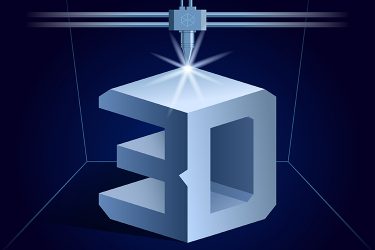Regulatory challenges and myths in pharmaceutical 3D printing
Posted: 16 February 2021 | Atul Kadam (Shree Santkrupa College of Pharmacy), Prachi Khamkar (Shree Santkrupa College of Pharmacy) | No comments yet
Although three-dimensional (3D) printing has been around for some time, many people still underestimate its capabilities. This article addresses the regulatory challenges faced by the pharmaceutical sector and aims to correct some of the most common myths surrounding the technology.


IMAGINE A FUTURE where patients with multiple disease conditions no longer have to take several tablets, numerous times per day. Instead, they can take one tablet containing all their required medications, once daily, thanks to 3D printing.
The process of 3D printing begins with a computer-aided format of a digital prototype of the product. The format is then sliced into horizontal layers that will form the shape of the digital file before being transfered into a 3D printer. Various excipients and drug combinations are then used to print the product with the aid of layering, transforming two-dimensional (2D) layers into a 3D product. Although the pharmaceutical industry is a laggard in this area, it is now waking up to the possibilities of 3D printing and we have witnessed various developments whereby specific tailor-made medicines can be manufactured according to a patient’s need.
Where are we now?
The four most frequently used 3D printing machines in the pharmaceutical industry are:
- Stereolithography (SLA)
- Fused deposition modelling (FDM)
- Selective laser sintering (SLS)
- Binder jetting (BJ).


In our view, there is a lack of 3D printing technology, education programmes and formal education systems that are necessary to drive the revolutionary capabilities of 3D printing in healthcare.1 Colleges and research institutes will play a significant game-changing role in bridging the knowledge gap of 3D printing by incorporating simple concepts into the curriculum and educating students about the process, along with its regulations and operations. In this way we can develop an education pipeline and produce potential research scholars.
For example, leading academics at University College London in the UK created FabRx, a specialist biotech company focused on developing 3D printing technology for fabricating pharmaceuticals and medical devices, with the goal of “creating printed dosage forms and drug‑loaded devices.” The company’s innovative printlet technology provides a medium for formulating and processing 3D-printed medicines for drug compounds, which includes polypills that can incorporate more than one medicine. FabRx prints drugs with various combinations of excipents and specific release profiles.
Regulatory issues
3D printing, especially for personalised medicine, has become a popular process and while there have been several attempts to scale up the technology, it is still in its infancy. Furthermore, the appropriate regulatory standards are necessary due to the large number of factors affecting the accuracy, quality and protection of computationally-engineered dosage forms.
As technology develops and the production of 3D-printed equipment continues, the FDA must stay abreast with 3D printing so that the technology can contribute to the production of personalised therapies”
Technology has been developed by creative groups to enable the construction of unique and customisable devices, allowing researchers to develop uniquely structured medical devices, customised according to a patient’s need.2 These new and unique 3D printing structures and applications have, however, introduced unique regulatory challenges. For example, SLS and FDM technologies cannot be compared because of different starting materials and process parameters; ie, powder and laser beams for SLS and filaments and powder bed temperature for FDM.
The US Food and Drug Administration (FDA) does not regulate 3D printers; however, it regulates 3D-printed devices. Presently, there is no valid product design, production and quality control regulation. Of note, regulation in 3D printing is mandatory; however, it has been stressed in an FDA paper that there is no potential to offer a single list of guidelines for all 3D printing methods due to the diversity of 3D printing techniques. Furthermore, development and legislative requirements might impose barriers to the dispensing of 3D-printed medicinal products.
Every development process needs regulatory guidelines and the FDA must respond to key questions, such as:
- What are the critical criteria for the printability of different materials in medicinal products?
- Which process parameters are important to 3D printing technology?
- How do we test a 3D drug product’s performance?
- How can we deduce whether the 3D geometry worked as it should?
- What are the main features of 3D print intermediates, such as 3D inkjets, filaments, substrates and cartridges?
- What are the main factors that influence the release rates and pathways of drugs when printed in 3D?3
Manufacturers also play an important role in setting up guidelines by providing supporting manufacturing steps, details and flow diagrams. This will help regulatory bodies understand the process faster.4
As technology develops and the production of 3D-printed equipment continues, the FDA must stay abreast with 3D printing so that the technology can contribute to the production of personalised therapies, including medications and biological products, in the future. The organisation will be advised to create a new regulatory system to ensure that individualised goods are safe and effective.
Common myths about 3D printing
It will destroy the environment
3D printing does not pose a threat to the environment; in fact, it could be beneficial if it is widely distributed. The shift towards the use of biodegradable and recycled materials is becoming more widespread and 3D printing is potentially greener than conventional methods of manufacture. Furthermore, objects made from a single element can be recycled easily.
It will steal our jobs
In industry, there is a widespread concern that technical advancements will kill employment. However, 3D printing has opened up opportunities relating to new tasks for a number of skilled experts. Research carried out by the global consultancy firm Kearney predicts there will be two to three million jobs in 3D printing by 2027.5 It is therefore likely that new technological revolutions like 3D printing, the Internet of Things (IoT) and artificial intelligence (AI) will change manufacturing processes in the future.
It is a new technology
3D printing has existed for over 30 years – SLA was invented in 1984 and the first 3D printer was launched in 1987. It is simply an old technology with a fresh label.
It will replace traditional manufacturing
3D printers are able to build certain personalised, low-volume components faster and more cheaply than traditional manufacturing processes. Some claim that 3D printing will replace traditional manufacturing; however, at high volumes, 3D printing components have substantially larger time and expense requirements than conventional production.
Only a single material can be deposited at a time
It is possible to use two or more materials simultaneously on several types of 3D printers. Known as multi-material 3D printers, they allow more complex shapes and designs than their single-material counterparts. This makes them more flexible than 3D printers with single materials. For example, a 3D printer made available in 2019 can deposit eight different materials at once.
It cannot make strong components
3D printing is often seen as a technology that can only generate fragile plastic components. This is a valid point, but only to a degree. A layer-composed part is usually less mechanical than a solid part. However, it would be incorrect to assume that all 3D-printed parts are weak. 3D printers with large layers or high infilling enhance the adhesion of sheets and improve the robustness of components.
The 3D printing market is not stable enough
In 2019, the 3D printing industry was worth $13.7 billion and is estimated to hit $63.46 billion by 2025, at a CAGR of 29.48 percent over the 2020‑2025 prediction period. 3D printing can be used to manufacture individual prescription therapies, providing a range of exciting possibilities for enhancing the health of patients. Recent research has shown that over 50 percent of customers are interested in purchasing personalised products and services.6 This demand would undoubtedly result in an increase in the market value of 3D printing by 2027.6
Conclusion
Although rapidly growing industries such as 3D printing receive a lot of hype, it is important to look beyond this and remain up-to-date with their technological capabilities and limitations. This allows us not only to grasp the real value of industrial 3D printing, but also to focus on the best practical applications for using this tool. The situation requires vision and prudent efforts to introduce reliable guidelines on regulations that ultimately lead to the success of this revolutionary technology. We believe that the distribution of personalised drugs to remote parts of the world, where drug supply chains are badly established, is one of the key aspects of 3D printing for the future.
About the authors


Prachi Khamkar is a research scholar and freelance writer based at Shivaji University, Kolhapur. She has two years of research experience in topical formulations. Her areas of interest include 3D printing technology and drug delivery. She has received numerous awards from scientific and professional bodies at national and international platforms. She has published several review articles and book chapters for international publications.


Atul Kadam is an Assistant Professor at Shree Santkrupa College of Pharmacy, Ghogaon, India. He has 12 years of experience in academic research and delivered several publications and presentations. His key research area is the formulation and development of pharmaceuticals.
References
- Adamo J, Grayson W, Hatcher H, Brown J, Thomas A, Hollister S et al. Regulatory interfaces surrounding the growing field of additive manufacturing of medical devices and biologic products. Journal of Clinical and Translational Science. 2018;2(5):301-304.
- Jamróz W, Szafraniec J, Kurek M, Jachowicz R. 3D Printing in Pharmaceutical and Medical Applications – Recent Achievements and Challenges. Pharmaceutical Research. 2018;35(9).
- Promise and Potential of 3D Printed Pharmaceuticals [Internet]. U.S. Food and Drug Administration. 2020 [cited 21 October 2020]. Available from: https://www.fda.gov/drugs/news-events-human-drugs/cder-researchers-explore-promise-and-potential-3d-printed-pharmaceuticals
- What the FDA Guidance on 3D Printed Devices Means for Medical Manufacturers [Internet]. Stratasys. 2020 [cited 21 October 2020]. Available from: https://www.stratasys.co.in/explore/blog/2018/what-the-fda-guidance-on-3d-printed-devices-means-for-medical-manufacturers
- 3D printing and the future of the US economy [Internet]. De.kearney.com. 2021 [cited 5 January 2021]. Available from: https://www.de.kearney.com/operations-performance-transformation/article/?/a/3d-printing-and-the-future-of-the-us-economy-article
- Markets, R. (2021). Global 3D Printed Drugs Market Forecast to 2027 – COVID-19 Impact and Analysis. Prnewswire.com. Retrieved 5 January 2021, from prnewswire.com/news-releases/global-3d-printed-drugs-market-forecast-to-2027—covid-19-impact-and-analysis-301148584.html
Issue
Related topics
3D printing, Drug Development, Drug Manufacturing, Industry Insight, Medical Devices, QA/QC, Regulation & Legislation
Related organisations
Kearney, University College London (UCL), US Food and Drug Administration (FDA)









